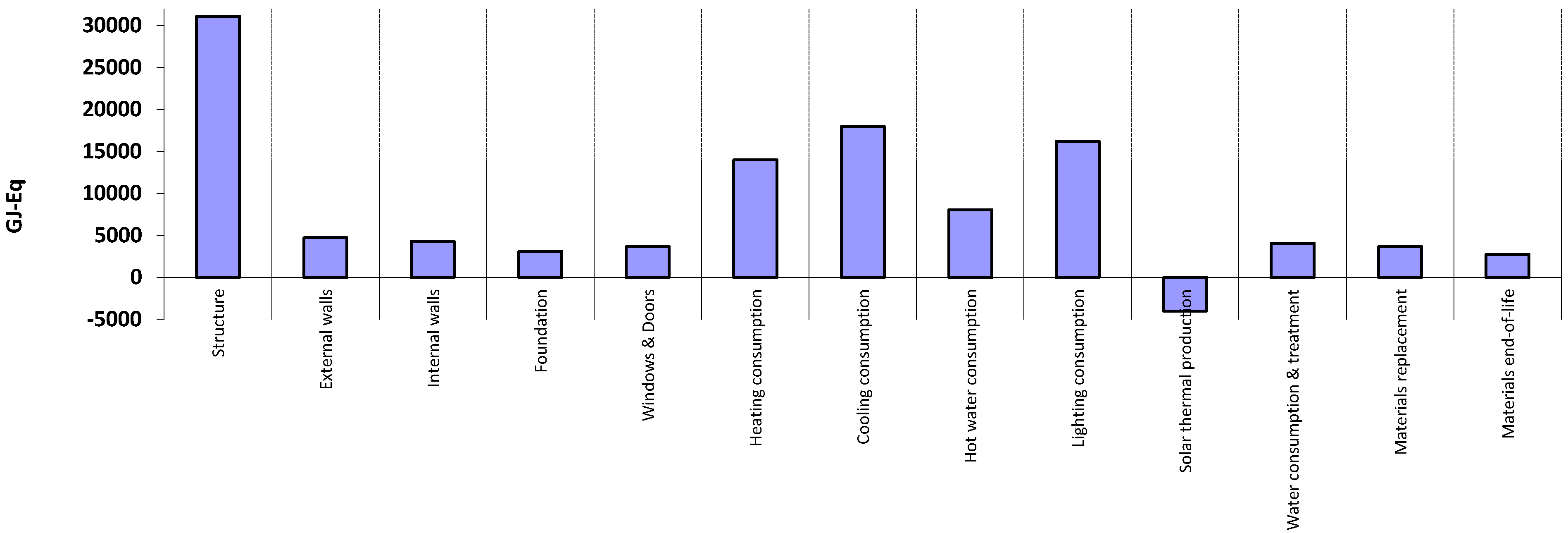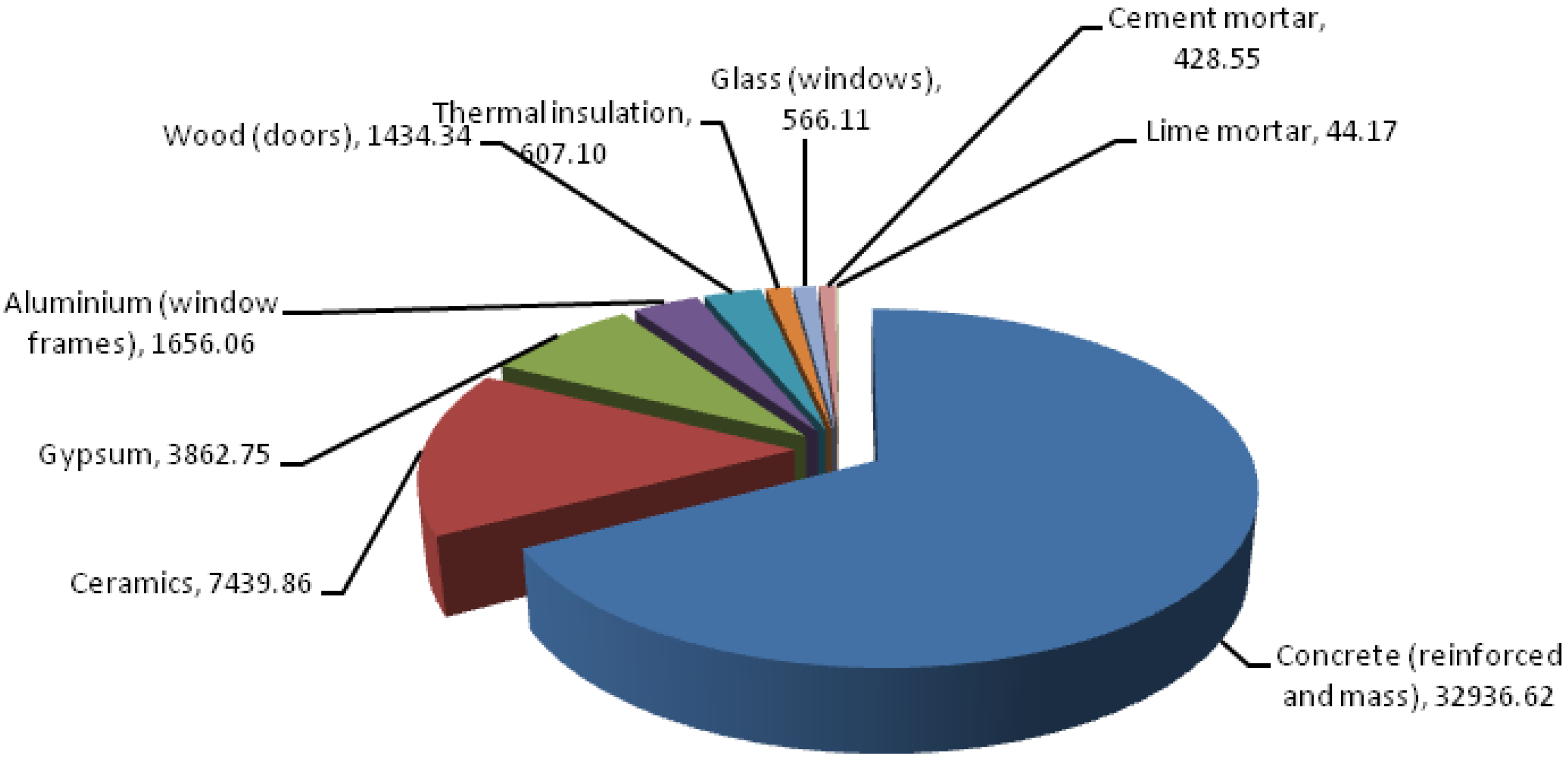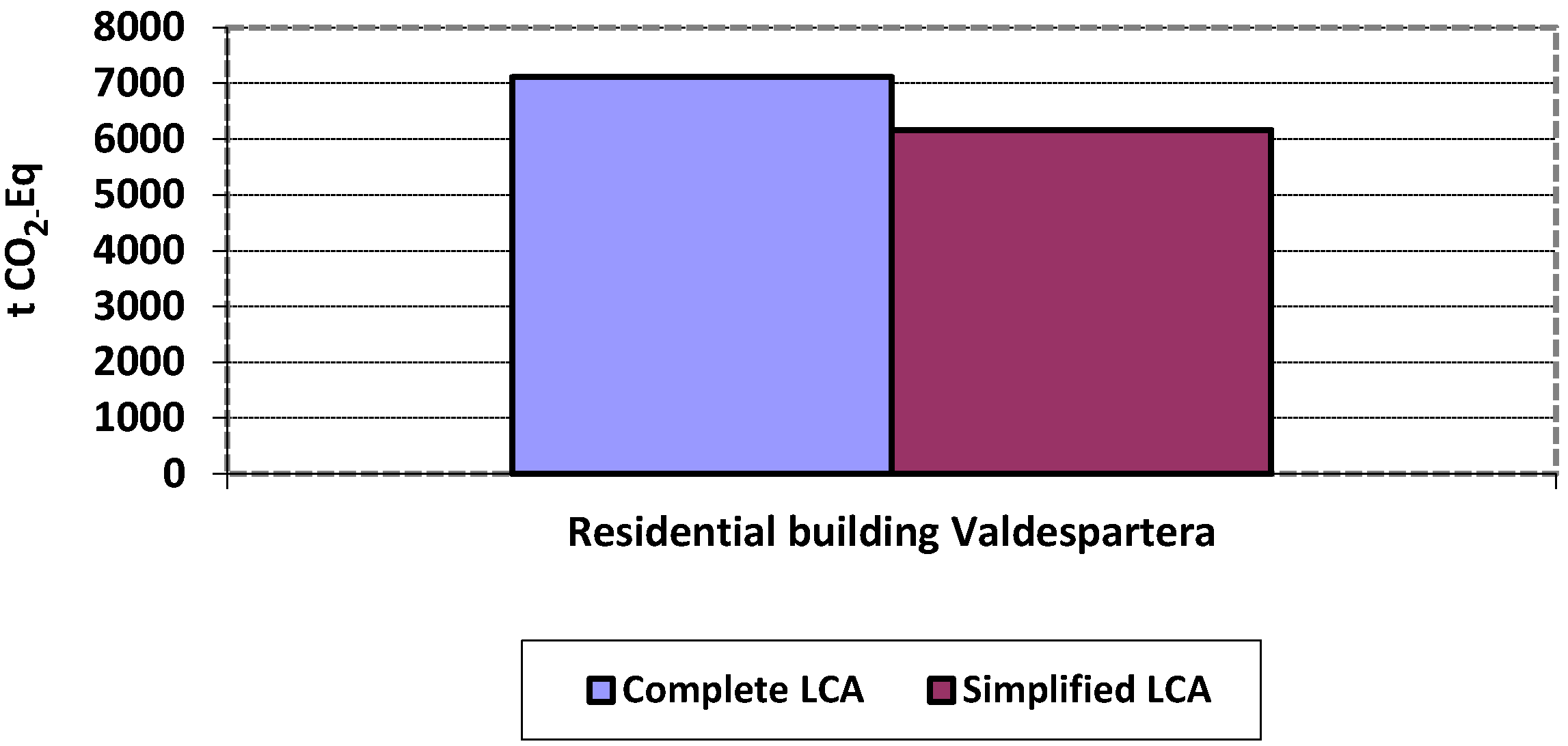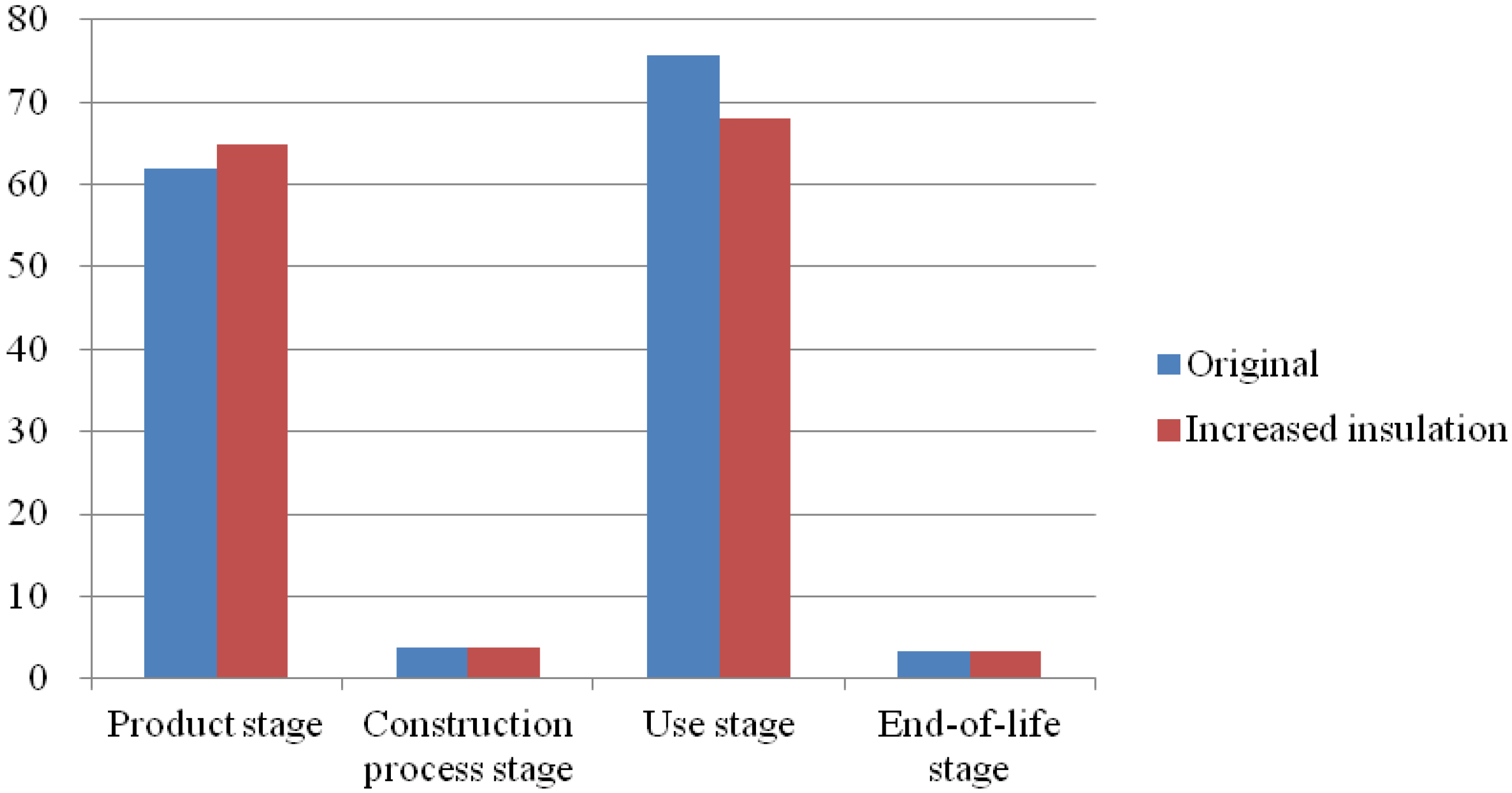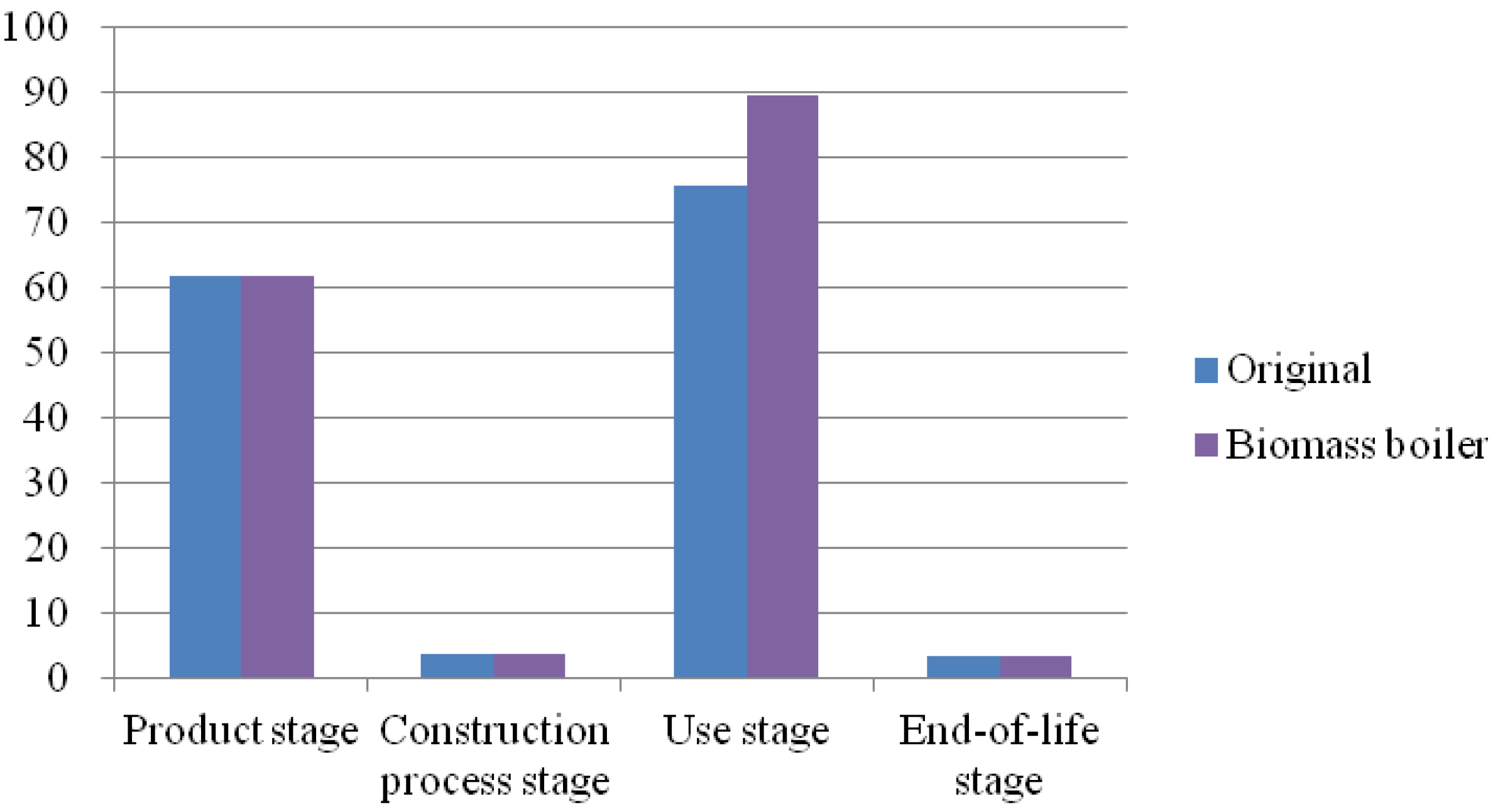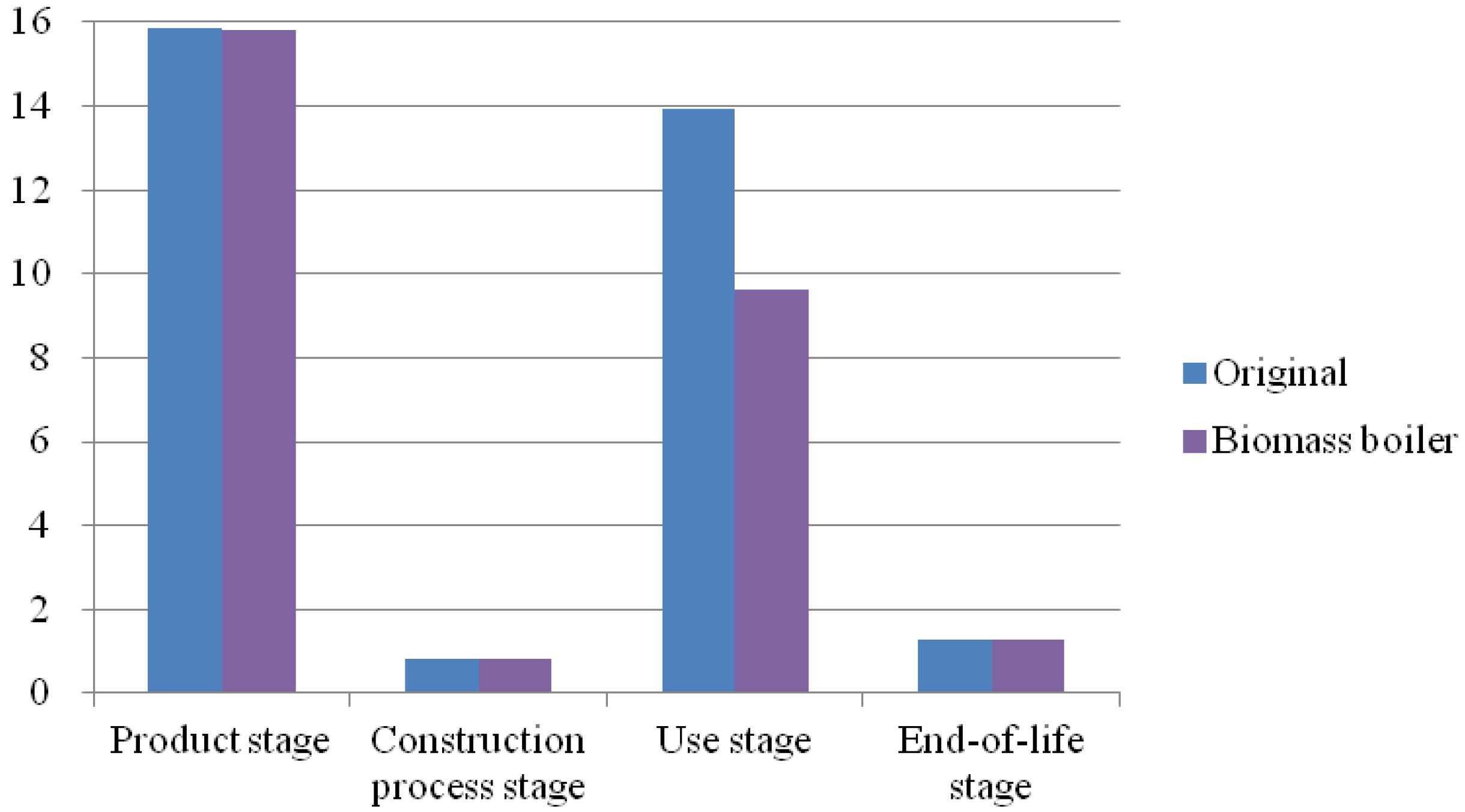3.1. Principles
The ENergy Saving through promotion of LIfe Cycle assessment in buildings (ENSLIC) Project, which was co-funded by the European Commission Intelligent Energy for Europe Programme and by nine European organizations that included more than 15 LCA experts and architects, sought to promote the use of LCA techniques in design for new buildings and for refurbishment, in order to achieve an energy saving in the construction and operation of buildings.
Starting with existing information generated from previous research projects the output was a set of guidelines with an LCA simplified methodology. The simplified methodology adopted a systematic approach guiding the user through the Life Cycle process and clarifying key issues that usually cause difficulty, e.g., choice of assessment tool, definition of system boundaries, options for simplifying the process,
etc. [
26].
In order to provide practical applications for the simplified methodology a series of case studies on real buildings were carried out by a number of previously trained collaborating target groups. In the cases studies, the impact assessment was based primarily on indicators of energy consumption and GHG emissions in line with the current environmental problems. However, the proposed methodology allows the consideration of other environmental indicators (energy and financial) always from a life cycle perspective. Through case studies, construction players are able to increase their knowledge on the energy and environmental specifications of different materials and building solutions. This way they have in their hands all necessary information to be able to consider energy and environmental impacts when making decisions on the selection of materials, suppliers and more eco-efficient production processes.
In this LCA study a building representative of the ecocity of Valdespartera (Zaragoza, Spain) was selected initially as a functional unit considering a service life of 50 years. Within the limits of the system, the four stages shown in
Table 1 and proposed by the technical committee―Sustainability of construction works CEN/TC 350: product, construction process, use, and end-of-life stage [
27] were included initially.
Regarding the data quality requirements, the existing inventories in the Ecoinvent v2.0 database [
28,
29] were initially selected and adapted to the Spanish electric mix and to the characteristics of the case studied.
The impact categories considered in this study were the primary energy demand (in MJEq or kWh-Eq) according to the CED method [
30] and GWP [
31] (in kg CO
2-Eq) according to the IPCC 2007 methodology [
32], considering a time horizon of 100 years. The software tool used in the study was SimaPro v7.3. (PRé Consultants bv, AD Amersfoort, The Netherlands)
Table 1.
Life cycle stages of a building based on the CEN/TC 350 standard, EN 15643-2 Sustainability of construction works-Environmental product declarations—Product category rules.
Table 1.
Life cycle stages of a building based on the CEN/TC 350 standard, EN 15643-2 Sustainability of construction works-Environmental product declarations—Product category rules.
| Stage | Module code | Module |
|---|
| I. Product stage | A1 | Raw materials supply |
| A2 | Transport |
| A3 | Manufacturing |
| II. Construction process stage | A4 | Transport |
| A5 | Construction-installation on-site processes |
| III. Use stage | B1 | Use |
| B2 | Maintenance |
| B3 | Repair |
| B4 | Replacement |
| B5 | Refurbishment |
| B6 | Operational energy use |
| B7 | Operational water use |
| IV. End-of-life stage | C1 | Deconstruction-demolition |
| C2 | Transport |
| C3 | Waste treatment |
| C4 | Final disposal |
3.1.1. Product Stage
This stage considered the supply of starting materials, the related transport needs and the manufacturing processes of all the materials used for the construction of the building, and of the main energy equipment of the building, including the cold and heat generators, and the equipment for making use of renewable energy, but excluding the storage and distribution equipment (such as tanks or piping). Therefore, it is a cradle to factory gate analysis. The data related to the construction materials was extracted from the building’s architectonic project, while the data on the equipment was taken from its air conditioning project.
3.1.2. Construction Process Stage
This stage evaluated the transport needs, from the factory door to the construction site, related to the construction materials and the energy equipment of the building. In all cases road transport by truck weighing 20–28 t at half load was considered.
Similarly, the energy consumption of the machinery necessary for constructing the building and the waste generated during the construction process including the transport and the final disposal of this waste were included. The impacts of manufacturing the machinery was deemed beyond the limits of the system as it was considered that this will be used in a good number of construction works.
It is estimated that to construct 1 m
3 of a building requires 0.8 m
3 of earthmoving and a consumption of diesel fuel of 0.104 kg (equivalent to 1.39 kWh), and that to construct, rehabilitate and demolish a building requires an electricity consumption of 0.30 kWh/m
3 [
33]. It is considered that 75% of this value is comparable to the electricity demand in the construction stage.
The study of waste management of each building has been based on the compliance of Spanish legislation which establishes the obligation to the construction and demolition waste producer to include in the execution project a study of the management of such waste, including the estimation of the quantity, expressed in t and cubic meters, from the construction and demolition waste that will be generated in the work. The amount of construction waste depends on project management, which may vary from one country to another.
The estimate of quantities is carried out with reference to the most common standard ratios on the volume and definition of construction and demolition waste. These ratios have been adjusted and adapted to the characteristics of the works according to automated calculation with the help of the computer programme “Construbit Residuos”, getting the ratios shown in
Table 2.
Table 2.
Ratios of amounts of construction site waste produced.
Table 2.
Ratios of amounts of construction site waste produced.
| Waste type | kg/m2 and floor | m3/m2 and floor |
|---|
| Packaging containing remains of dangerous substances or contaminated by them | 0.05 | 0.0009 |
| Gas in pressurized containers containing dangerous substances | 0.02 | 0.00008 |
| Concrete | 0.41 | 0.28 |
| Roof tiles and ceramic materials | 0 | 0.00003 |
| Wood | 2.85 | 0.008 |
| Plastics | 1.07 | 0.002 |
| Earth and stones | 8.5 | 0.006 |
| Mixed construction waste | 1 | 0.002 |
| Paper and cardboard | 0.35 | 0.0009 |
3.1.3. Use Stage
The use of the building includes all the impacts associated with the operation and maintenance of the building throughout its whole useful life. The operation of the building covers the consumption of final energy to meet the demand for heating, cooling, sanitary hot water and interior illumination of the building, the water consumption and the treatment of the wastewater generated. In all cases, in addition to the impact associated with the consumption itself, the impact of the energy (electricity and gas) and water supply infrastructure for the building was evaluated.
The demand and the final energy consumption of the building analysed was calculated using the tools Lider and Calener VYP [
34], that incorporate hourly-based dynamic simulation calculations. When assessing the impact associated with the final energy consumption, the production values of renewable origin were deducted from the consumption of the building.
The impact due to the use of water in the building includes the transport (pumping) and treatment (filtering and purification) of the water consumed from its collection to its consumption in the building. To calculate the water consumption of the building the ratios calculated by the City Council of Zaragoza using municipal monitoring studies carried out in various residential buildings were used.
Similarly the impact of treating the wastewater generated in the building was assessed, including the energy consumption corresponding to the treatment plant and the infrastructure necessary to take the water from the building to the outflow site.
Within building maintenance, only the replacement of windows and doors, and of the energy generation equipment, every 25 years was included. The technical cleaning work and repainting of the building’s walls and possible repairs and corrective maintenance operations required throughout its useful life due to the energy systems and building enclosures were deemed beyond the limits of the system as their incidence on the total impact was expected to be lower.
The impact of the maintenance includes the impact associated with the manufacture of the new products and equipment, their transport from the factory to the building and the final disposal of the products and equipment replaced. For simplicity, it was considered that the technical specifications of the new products and equipment would be similar to the original ones.
3.1.4. End-of-Life Stage
Within this stage, the processes of deconstruction, transport and final disposal of all the construction materials and the energy equipment used throughout the service life of the building were considered.
For each material its most probable final disposal scenario is considered—disposal in dumps or incinerators or shipment to classification plants for recycling. It is important to note that currently in Spain more than 80% of the CDW is disposed of in dumps, so direct or partial recycling is clearly a minority.
According to the method established by Ecoinvent, the processes of recycling and external evaluation are beyond the limits of the system analysed. Thus, its positive effects are considered only in the new product created using this waste.
